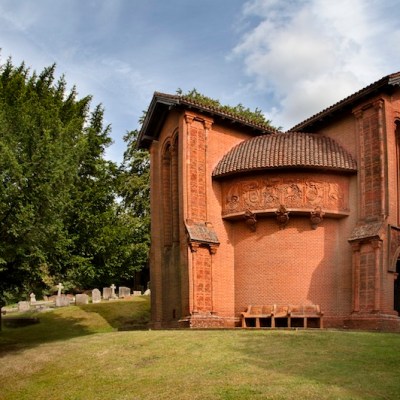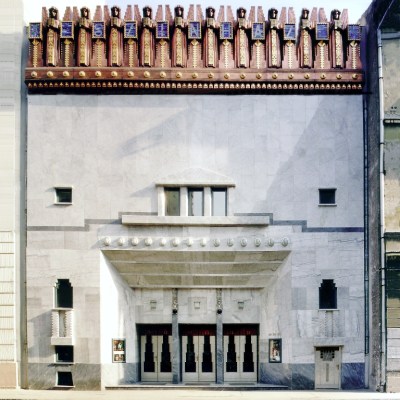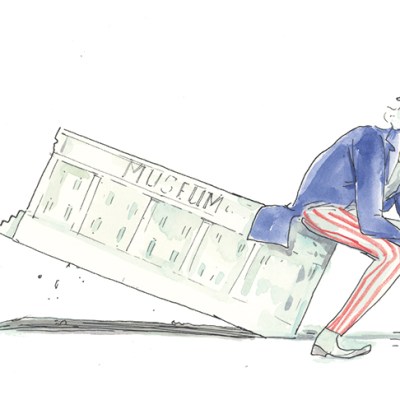From the February 2022 issue of Apollo. Preview and subscribe here.
We have become used to the white stone cliffs of the museums on Washington’s National Mall – neoclassical, over-scaled and austere – but it might all have looked very different. The very first of the Smithsonian buildings, now known as the Castle, is an asymmetrical medley of towers and arches, an odd cocktail of German gothic, Oxbridge college and European fairy tale, built in 1855. The Castle, now the Smithsonian’s visitor’s centre, was designed to be a research institute, rather than a museum. The Smithsonian’s second building was the first purpose-built museum on the Mall. Built in 1881, the Arts and Industries Building (AIB) is a vast Gothic Revival shed that looks more like a railway station or a prison than a museum. Closed for renovation since 2004, the AIB finally reopened last November, providing the opportunity to see this intriguing structure once more and be reminded of the remarkable life of its now little-known architect.
Adolf Cluss (1825–1905) was born in Heilbronn in south-west Germany. His father was a master builder and Cluss junior was apprenticed as a carpenter, travelling through the German states for work. On his travels he encountered Karl Marx, who became a friend and lifelong correspondent. In his twenties, Cluss became a revolutionary, an early member of the Communist League and the workers’ council of Mainz. Disillusioned by the failure of the 1848 revolutions, Cluss joined many other dejected radicals in the long journey to the New World. He disembarked in New York City where he stayed for a few months to acclimatise and learn a little English before eventually alighting in Washington, D.C. in 1849. The capital was very much a city in the making and Cluss was determined to make his mark. He spent his first decade on engineering projects and navy yards (he also designed a cannon for the navy) but by the early 1860s he was in private practice and in high demand.
Cluss’s buildings created the framework for everyday life in a way none of the city’s more famous landmarks could. He built schools, market halls, fire stations, federal offices, department stores, apartment blocks, navy yards, houses for the wealthy and masonic temples. He had no peers in his prolific output and, even though most of his work has since been demolished, those buildings that survive indicate why he was so successful and so influential. The Eastern Market, for instance, brings a bit of brick Baltic to Capitol Hill while the huge Franklin Hill School still towers over K Street, albeit now housing a museum.
The East Hall of the Smithsonian’s Arts and Industries Building. Photo: Ron Blunt; courtesy Smithsonian

For the Arts and Industries Building Cluss and its first curator, George Brown Goode, deliberately eschewed the model of the grand classical museums of Europe (which, ironically, would become the model for the rest of the Mall) and looked to the hugely popular World’s Fairs. The recent success of the Centennial Exposition in Philadelphia in 1876 spurred Cluss to create a vast, flexible shed, which could display anything from massive machines to dinosaur skeletons and accommodate balls and ceremonies.
It was a model that aimed to appeal to the masses. Unlike most institutions of its time, the Arts and Industries Building (the word ‘museum’ does not even appear in its title) is not placed atop a grand set of stairs. It is not made of marble but of workmanlike brick. It is not fronted by a classical portico of any kind and was designed to be open to all cardinal points of the city, with four doors addressing every direction.
With its twin pointed towers and central rotunda the AIB contains echoes of both church and penitentiary. The heavy Rundbogenstil-inflected architecture is alleviated by glazed arcades and openings reminiscent of the market halls Cluss was building in the same period. Inside it has a floor of polychromatic encaustic tiles and painted decorations that make it look like a central European synagogue. It boasts grand spaces and odd niches, a gallery level that was added as an afterthought and a central rotunda that acts as a huge sundial.
Despite my enthusiasm for its flexibility and verve, it is not (we can safely say) a beautiful building, but it is solid, civic and determinedly accessible. There are no barriers to entry: not only no steps but no daunting lobby or narthex either; the entrance deposits the visitor straight into the Greek Cross of the plan.
Cluss’s original drawings showed an empty interior, a container for as-yet-unknown displays. If its architect had looked to history, the museum looked to the future for its content. From the statue which stood in the rotunda, a female figure holding aloft a lightbulb barely months after Edison laid claim to inventing it in 1879, to the rockets that flanked its entrance like spindly sentinels when it was the National Air and Space Museum in the 1960s and ’70s, this building has displayed the inventions which would change the world. It seems entirely appropriate that the AIB has now reopened with an installation called, simply, ‘Futures’ (until 6 July). Designed by the architect David Rockwell and with Glenn Adamson as consulting curator, this is a broad survey of the technological issues facing us almost a century and a half after the building first opened. The exhibition occupies only the central section of the building, the four cavernous corner halls remain empty and there is a sense that this vast structure contains all manner of possibilities.
When I speak to the director, Rachel Goslins, she is circumspect about her plans, indicating that ideas for a museum of women and of Latino culture are in the air. This indeterminate museum can appear more modern than many of the 20th-century institutions on the National Mall. Even its nearest neighbour, the Gordon Bunshaft-designed Hirshhorn Museum, seems static by comparison, despite its deliberately circular and dynamic form, and has failed to prove itself particularly adaptable.
Brown Goode, Goslins tells me, said that ‘a finished museum is a dead museum and a dead museum is useless’. Now in its 175th year, Cluss’s building appears resolutely unfinished. It has always been a museum of the future and it seems perfectly apt that its own future is uncertain.
From the February 2022 issue of Apollo. Preview and subscribe here.


